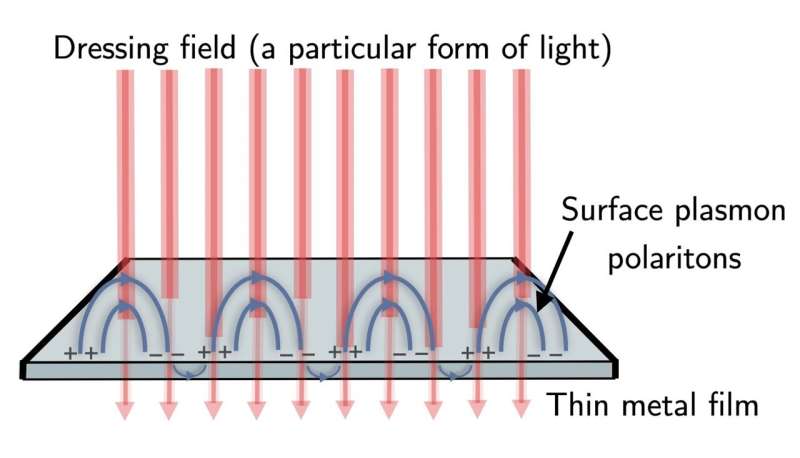This schematic shows how an external field ( a particular form of light) can be used to control the electrical conductivity of a thin metal film to enhance its plasmonic properties. Here, the blue lines show the long-lasting surface plasmonic modes excited on the thin plate because of the favorable conductivity change from the light imping on the thin metal plate. The red beams depict the dressing field applied to the metal film. Credit: Kosala Herath and Malin Premaratne
Over the past few decades, the field of data processing and transferring technology has advanced at a rapid pace. This growth can be attributed to Moore's Law, which predicts that the number of transistors on a microchip will double roughly every two years, enabling the semiconductor industry to make electronic devices smaller, faster, and more efficient.
However, electronic interconnections have presented challenges in data transferring due to delays and thermal issues that limit capacity. In an effort to address this issue, researchers have turned to the use of optical waves instead of electronic signals. Optical waves offer significant information-carrying capacity and minimal loss, but the challenge lies in miniaturizing photonic devices as much as electronic components.
Enter plasmonics, a research area that combines microscale photonics and nanoscale electronics to overcome this limitation [1]. Using surface plasmon polaritons (SPPs) to deliver light energy between nanophotonic devices, plasmonics offers a high degree of confinement, overcoming the limitations of conventional dielectric waveguides. With plasmonics, it is possible to manipulate light at the nanoscale and create a world of possibilities for the future of data processing.
However, a significant challenge arises in simultaneously achieving longer propagation lengths and highly confined SPP modes. This is where Floquet engineering comes in. This cutting-edge technology transforms quantum material engineering through high-intensity periodic driving, allowing researchers to manipulate matter in previously considered impossible [2, 3].
To address this challenge, we have proposed a comprehensive theoretical framework that uses quantum electrodynamics coupled with Floquet engineering to enhance the propagation length of SPP modes [4]. By modifying the electrical and optical characteristics of metal nanostructures within plasmonic waveguides, it is possible to enhance SPP propagation lengths significantly.
It was observed that exposing a metallic system to this particular form of light (dressing field) increases the propagation length of SPP (surface plasmon polariton) modes due to an enhancement in the metal's conductivity. This can be explained by the fact that SPPs are created by the collective movements of electrons in the metal, and the metal's energy loss can be attributed to electron scattering. Dressing by the external field modifies the wave functions and, thereby, the rates, which can improve the conductivity and increase the propagation length of SPP modes.
Finally, the plasmonic and conductive properties of popular plasmonic metals, including silver (Ag), gold (Au), copper (Cu), and aluminum (Al), were analyzed under the illumination of a particular form of light using computer simulation based on code specifically written to explore this novel observation. Based on the evaluation, several metals were found be much suited for application due to their controllable conductivity response. This discovery could lead to the development of efficient and advanced nanoscale plasmonic data processing devices, circuits, and components in the near future.
This story is part of Science X Dialog, where researchers can report findings from their published research articles. Visit this page for information about ScienceX Dialog and how to participate.
More information: [1]. Malin Premaratne and Govind P. Agrawal, Theoretical foundations of nanoscale quantum devices, Cambridge University Press (2021). doi.org/10.1017/9781108634472
[2]. Kosala Herath and Malin Premaratne, Generalized model for the charge transport properties of dressed quantum Hall systems, Physical Review B (2022). DOI: 10.1103/PhysRevB.105.035430
[3]. Kosala Herath and Malin Premaratne, Polarization effect on dressed plasmonic waveguides, Emerging Imaging and Sensing Technologies for Security and Defence VII (2022). DOI: 10.1117/12.2635710
[4]. Kosala Herath and Malin Premaratne, Floquet engineering of dressed surface plasmon polariton modes in plasmonic waveguides, Physical Review B (2022). DOI: 10.1103/PhysRevB.106.235422
Bio:
Kosala Herath is a Ph.D. candidate and a member of the Advanced Computing and Simulations Laboratory (qdresearch.net/) at the Electrical and Computer System Engineering, Monash University, Australia. He received his B.Sc. degree in Electronic and Telecommunication Engineering (with first-class honors) from the University of Moratuwa, Sri Lanka in 2018. Currently, his research focused on the fields of nanoplasmonics, low-dimensional electron transport, and Floquet systems. He is a member of SPIE.
Malin Premaratne earned several degrees from the University of Melbourne, including a B.Sc. in mathematics, a B.E. in electrical and electronics engineering (with first-class honors), and a PhD in 1995, 1995, and 1998, respectively. He has been leading the research program in high-performance computing applications to complex systems simulations at the Advanced Computing and Simulation Laboratory, Monash University, Clayton, since 2004. Currently, he serves as the Vice President of the Academic Board of Monash University and a Full Professor. In addition to his work at Monash University, Professor Premaratne is also a Visiting Researcher at several prestigious institutions, including the Jet- Propulsion Laboratory at Caltech, the University of Melbourne, the Australian National University, the University of California Los Angeles, the University of Rochester New York, and Oxford University. He has published more than 250 journal papers and two books and has served as an associate editor for several leading academic journals, including IEEE Photonics Technology Letters, IEEE Photonics Journal, and OSA Advances in Optics and Photonics. Professor Premaratne's contributions to the field of optics and photonics have been recognized with numerous fellowships, including the Fellow of the Optical Society of America (FOSA), the Society of Photo-Optical Instrumentation Engineers USA (FSPIE), the Institute of Physics U.K. (FInstP), the Institution of Engineering and Technology U.K. (FIET), and The Institute of Engineers Australia (FIEAust).
Journal information: Physical Review B
























